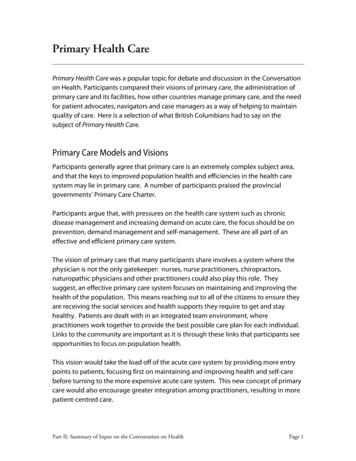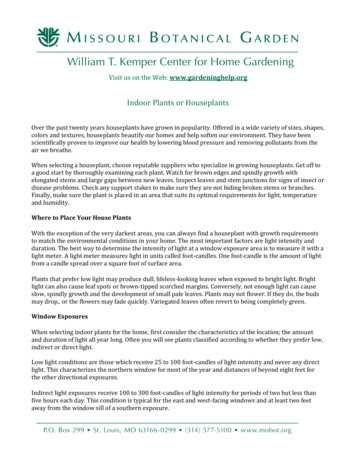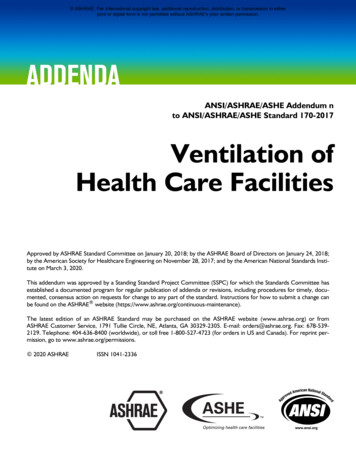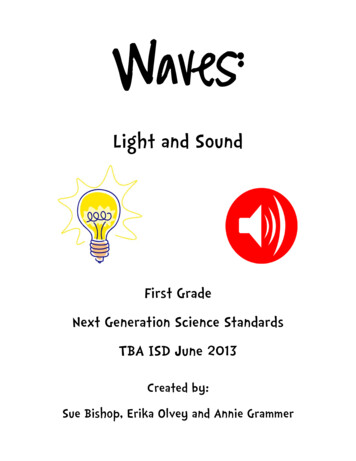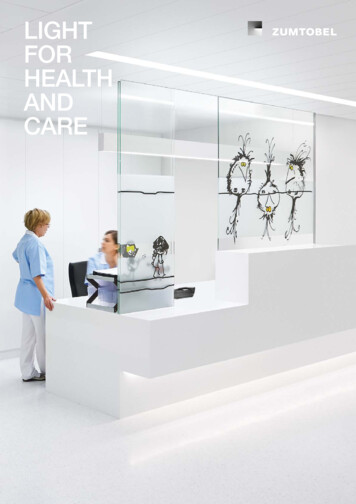
Transcription
LIGHTFORHEALTHANDCARE
Light for Health and Care
Hardly any other application area demands such complex lighting solutions ashealth and care facilities, where an extremely wide range of requirements have to bemet in order to create perfect conditions: doctors and care staff need different lighting situations in order to perform tasks that require high levels of concentration.Efforts are also made to achieve a feel-good atmosphere for patients. Lightingtherefore has to cater for the needs and preferences of various groups of individualsin different situations. Zumtobel’s intelligent lighting solutions reconcile these disparate requirements and interests.Thanks to extensive research, we know how light can affect mood and well-being.Our product development and consultancy work take into account the results ofinternational research studies. The primary purpose of lighting in hospitals is toimprove the quality of the patient’s stay, thereby also aiding recovery. The emphasisin care facilities is on using light in the right way to improve quality of life, for example to compensate for inadequate daylight by providing dynamic lighting solutionsthat mimic changes in daylight over the course of a day. Innovative technologies andintelligent controls also minimise energy consumption. This is how Zumtobel strikesa balance between lighting quality and energy efficiency.Zumtobel. The light.
ApplicationsSt. Franziskus Care Home, Marsberg DERüsselsheim Clinic DEMaldegem Care Home BEHamburg-Eppendorf University Clinic, Hamburg DE
Gmunden Regional Hospital ATDr. Martin Ladentrog Dental Practice, Graz ATElisabeth Residential Care Facility, Breda NLOffenbach Clinical Centre DE
References
Bad Soden Cardiac Centre, DE Bregenz Regional Hospital, AT Brothers of MercyHospital, Salzburg, AT Cantonal Hospital Basel, CH Caritas Socialis Vienna, AT Centre Hospitalier, Mouscron, BE Children and Pediatric Hospital, Dammam, SA Chur Hospital, CH CHUV Maternity, Lausanne, CH Constance Clinics, DE DornbirnHospital, AT Elisabeth Residential Care Facility, Breda, BE Erasmus MC, Rotterdam,NL Franz-Tappeiner Hospital, Merano, IT Fujairah Private Hospital, AE GeneralHospital, Biljurashi, SA General Hospital, Sakaka, SA Geneva University Hospital,CH Gmunden Regional Hospital, AT Göttingen University Clinic, DE Graz RegionalHospital, AT Gynaecological Clinic, Lucerne, CH Hamburg-Eppendorf UniversityClinic (UKE), DE Innsbruck Regional Hospital, AT Klagenfurt Regional Hospital, AT Liesing Geriatric Centre, AT Lippe Detmold Clinical Centre, DE Maldegem CareHome, BE Marien-Hospital, Witten, DE Marienkrankenhaus, Hamburg, DE MCRZRotterdam, NL Medicity Gurgaon, IT Minden Clinical Centre, DE Oberaich Centrefor Care of the Elderly, AT Offenbach Clinical Centre, DE Ospedale Trento, IT Ospedale Verona, IT Paracelsus Clinic, Osnabrück, DE RSA G. Frisia, Merate, IT RSA Mazzali, Mantova, IT RSA Morelli Bugna, Verona, IT RSA Selvazzano, Padova,IT Salzburg Regional Hospital, AT St. Georg Municipal Clinical Centre, Leipzig, DE St. Katharina Vienna, AT St. Pölten Regional Hospital, AT Szpital Wojewodzki,Slupsk, PO Triemli Municipal Hospital, Zurich, CH Twente Universiteit, NL UZ Ghent,BE Vienna General Hospital, AT Wroclaw Hospital, PL Zollikerberg Hospital, CH
Photo on front cover: Municipal Hospital, Dornbirn ATArchitects: Architekturbüro Gohm und Hiessberger, Feldkirch ATLighting solution: SLOTLIGHT, SUPERSYSTEM, PURELINE, LIGHT FIELDS
TrendsLight for Health and Care101 Attractivenessand well-beingQuality for patients and persons who require careStructuring timeIncreased well-beingImproving convenienceEnsuring safety12141618202 Space and capacitySupport for doctors and care staffMaking work easierRecognising detailsTaking time into accountBeing flexible22242628303 Cost savingsAdded value for operators and investorsReducing energy consumptionImproving cost-effectivenessImage enhancementTaking a holistic view3234363840Tour round a hospitalSteps towards a trend-setting lighting solution42ELI checklistsAssessing lighting quality4350 % reduction in CO²emissions thanks toLED lighting aloneExamples taken from various application areasEntrance area reception comparison exampleCorridor comparison exampleCafeteria comparison exampleWaiting area comparison exampleExamination room comparison exampleSurgery hallway comparison examplePre-op room comparison exampleOperating theatre comparison exampleTwo-bed room comparison exampleSingle-bed room comparison exampleOffice comparison example444648505254565860626466Lighting managementLighting control for hospitals and care settings68Emergency lighting/escape sign luminairesInconspicuous day to day, dependable in emergencies70ONLITE local andONLITE centralZumtobel‘s emergency lighting systems71Sustainable lightingenhances well-beingMunicipal Hospital, Dornbirn AT72Dynamic lightingKarolinska University Hospital, Huddinge SE74Research projectSt. Katharina Residential Care Home, Vienna AT75Skills overviewClosely meshed network76
TrendsLight for health and care1Attractiveness and well-beingAgainst a backdrop of demographic change and an ageing population, a highly-qualified, motivated workforce is absolutely vital.Patients choose the hospital that will give them the best care. Wesupply the best lighting designed to enhance well-being amongstaff and patients by using premium lighting solutions to create apleasant, refreshing room atmosphere.Reasons for choosing LED:– Variable light colours– Can be controlled appropriately to needs– Versatility and high lighting quality(good colour rendering, high-precision direction of light)Resulting in:– Attractive scenarios for any time of day or activity– Individuality
1123Space and capacityCost savingsHealthcare and nursing providers are constantly confronted by theproblem of limited available space. Sufficient infrastructure andspare space must be kept available to cope with emergencies suchas epidemics but, on the other hand, recurring costs must be keptas low as possible.Costs play a key role in the healthcare and nursing sector in the EUand in most international markets. These costs include, among others, the costs of qualified staff, property maintenance, operatingcosts and the expenses incurred during a stay in hospital. Premiumlighting solutions can aid convalescence, thus shortening hospitalstays, which in turn results in cost savings.Reasons for choosing LED:– Small size– Can be integrated into architecture/furniture– Individually controllable/addressableReasons for choosing LED:– Highly efficient– Maintenance-free– Easy to controlResulting in:– Spatial flexibility– ExpandabilityResulting in:– Energy savings and reduced CO ² emissions– Low operating and maintenance costs– Lower total costs over a system’s entire life cycle
Attractiveness and well-beingQuality for patients and persons who require care“It’s especially important that dementia sufferers feel safe and secure. Everythingmust be done to make sure they do. Sufficient light of the right quality helps givedementia sufferers sense of safety and security. Circadian light helps establish agood day-night rhythm and reinforces the “interplay” between day and night. It canalso improve sleep quality and daytime wakefulness. This can make nursing andcare a more positive experience for both patients and staff.”Michael SchmiederDirector Sonnweid Care Home, Wetzikon CH
131Kittsee Care Home ATArchitecture: Arch. Prof. Ing. Mag. Heinrich Wolfgang Gimbel, Oberwart ATLighting solution: LIGHT FIELDS surface-mounted luminaires,PURELINE bedside luminaires, SCONFINE SFERA pendant luminaires,SLOTLIGHT light lines, ONLITE COMSIGN LED escape sign luminaires,ONLITE RESCLITE emergency luminaires, LUXMATE BASIC lighting controlsystemDemographic changes in most European countries mean that the numbers of elderly people who will need care is set to rise sharply over thenext few decades. The elderly have different needs. Lighting designmust take this fact on board and take it seriously in order to enable theelderly to lead autonomous lifestyles. Eyesight deteriorates drasticallywith age, 3D perception grows worse and sensitivity to glare increases. Insufficient daylight disrupts sleep-wake rhythms. Freedom ofmovement also becomes restricted with age. Lighting can be used torespond to these altered requirements, thereby redefining residents’and patients’ quality of life. Higher lighting levels make it easier for patients to see, even when performing simple visual tasks, and uniformilluminance levels ensure greater safety, especially in corridors.
1A ttractiveness and well-beingStructuring time The right lighting helps synchronise biological rhythms andworks in harmony with them Colour temperature and lighting intensity can mimic thoseof natural daylight over the course of a day Nature is the perfect model for pleasant, refreshing lightingBesides its functional and emotional components, lighting also hasa non-visual, biological effect on humans. Light also provides animportant time base for circadian sleep-wake rhythms. However,due to restricted mobility or unfavourable building layouts, there isoften no easy access to daylight in hospitals and care facilities.Biological rhythms are quickly thrown out of balance, which has animpact on well-being and productivity. The elderly, in particular,have an innate need for larger amounts of light and, when there isnot enough daylight, they experience night-time insomnia. This cancause unease and anxiety which make them less active and adversely affect well-being.This phenomenon is especially pronounced in the case of patientssuffering from Alzheimer’s or dementia. Studies conducted in various care homes show that high lighting levels in day rooms have apositive, stimulating effect on sleep-wake rhythms. Lighting levelsup to 1500 lx are recommended at certain times. Colour temperatures that mimic natural changes over the course of a day have apositive impact. Warm light in the morning and evening fosters asense of well-being and relaxation. Bluish light in the late morningand at midday has a stimulating effect. This daylight feel makescare patients more mobile, more active and more communicative.These increased activity levels result in the body producing moremelatonin in the evening; this makes residents feel tired in the evening and therefore more likely to get a good night’s sleep. This provides better “cues” for the body clocks of elderly people in a waythat they have become accustomed to during their active workinglives.High-quality lighting is also effective in hospitals, especially in intermediate and intensive care units. We perceive light subconsciously,and it ensures well-balanced biological rhythms. Natural light inwaiting areas and patients’ rooms creates a sense of ease and promotes subsequent patient convalescence and health.Product recommendationsCIELOS multicolor Surface-mounted luminaireLUXMATE LITENET Lighting management
15Helios Care Home Goldach CHArchitecture: F. Bereuter AG, Rorschach CHLighting solution: special-design luminaires
1A ttractiveness and well-beingIncreased well-being Lighting scenes that feature variable light intensities, directions of light and light colours create feel-good atmospheres Light and materials can merge into a single entity, thus lendingeven sterile spaces a homely note Individually adjustable daylight integration speeds up patientconvalescencePatients’ rooms play a crucial role in the recovery process. The rightlight can make a perceptible contribution towards making patientsfeel secure and at ease, despite being in an unfamiliar environment.A pleasant atmosphere also leaves its mark on doctors who providetreatment, care staff and visitors.Light becomes a feel-good factor if the light colour, direction of lightand its intensity are appropriate to particular situations and producevarious room scenes: at visiting times, communicative lighting withdaylight-like, natural light and well-balanced light distribution has ahighly agreeable effect. In contrast, a more muted lighting scene isfine for reading. Simple, intuitive operation makes sure that evenpeople with reduced mobility and physical and psychological healthproblems can operate the lighting system with no difficulty.A light colour that interacts with the furniture, materials and colourschemes in the room periphery gives a room a homely feel. This isthe approach that is also adopted by products that integrate lightand a medical supply system in a wall-mounted system that hidesthe technology from view. Premium products are also distinguishedby time-saving installation and easy operation for lighting controlthat integrates daylight and delivers the desired lighting scene atthe press of a button.Product recommendationsIMWS Medical supply systemZBOX Lighting management
17Green Hospital CooperationLighting solution: IMWS integrated medical wall-mounted system
1A ttractiveness and well-beingImproving convenienceCasa di Cura privata “Sanatrix”, Rome ITArchitecture: STA Nervi-Feliciangeli, Rome ITLighting solution: LIGHT FIELDS surface-mounted luminaires,CIELOS luminous ceiling, SLOTLIGHT light lines, ONLITE RESCLITEemergency luminaires, LUXMATE BASIC lighting control system
19 Well-balanced luminance levels are perceived as pleasant Daylight has a natural, agreeable effect Simple operation is a basic requirementWell-balanced luminance levels are easiest achieved by using several light components: luminaires with visible luminance levels, for instance, are an ideal addition to vertically illuminated surfaces andhelp improve human spatial perception. Adequate luminance levelsare required in meeting areas to ensure straightforward orientationand safe movement. The fact that corridors are places where peoplemeet and communicate in many hospitals, retirement homes andcare homes and are frequented by many patients with impairedvision is a powerful argument in favour of a high-quality lighting solution. The legally required minimum illuminance in corridors is therefore inadequate. In corridors, Zumtobel recommends luminance ofaround 300 lx with special attention being paid to uniformity.Light and a sense of well-being are always closely linked. If insufficient daylight is available, artificial lighting must compensate for thisand provide optimal illumination with high levels of visual comfort.While daylight is inherently variable, an intelligent controller is required to be able to adapt artificial lighting to suit the time of day. Inareas that are used by the public, an automatically adjusted lightinglevel is perceived as being pleasant. In contrast, individuality needsto assert itself in spaces used by individuals such as patients’rooms. Logical, simple operation that even the elderly, frail or visuallyimpaired and dementia patients can understand is the top priority inthese situations.Product recommendationsPERLUCE Surface-mounted luminaireMaldegem Care Home BEArchitecture: AIKO Architecten & Ingenieurs, Maldegem BELighting solution: PANOS downlights, COPA pendant luminaires,SLOTLIGHT light lines, CLARIS pendant luminaires, KAREA wallmounted luminairesONDARIA Circular luminaire
1A ttractiveness and well-beingEnsuring safety Patients and staff alike can find their way round more quickly Avoiding glare means preventing accidents Uniform brightness enhances lighting comfortBesides the way that space is divided up and interior design, lighting and luminaires are important factors when it comes to ensuringstraightforward orientation in buildings. The elderly are especiallysusceptible to glare and this can have negative consequences under some circumstances. Glare reduces a person’s perception oftheir environment. A good lighting solution that takes into accountsurfaces and their reflectiveness precludes the possibility of glare.Uniform brightness makes potential danger spots clearly visible. Ithelps negotiate shadowy or dark areas which the elderly are proneto regard as trip hazards. Good lighting becomes more importantas we age. This is why the brightness levels specified by standardsand regulations are not sufficient to ensure requisite levels of safetyin care facilities. This safety can only be achieved through a wellbalanced, bright lighting scene. Emergency and escape sign luminaires that are easy to identify from afar and brighten up a roomsufficiently in an emergency make finding an escape route safer andfaster.Product recommendationsONLITE ERGOSIGN Escape sign luminaireSLOTLIGHT II Recessed luminaireGmunden Regional Hospital ATArchitecture: fasch&fuchs architekten, Vienna ATLighting solution: PANOS downlights, TECTON Tetris continuous rowsystem, SLOTLIGHT light lines, RAIN moisture-proof luminaires,PURELINE bedside luminaires, CONBOARD medical supply units,LUXMATE LITENET lighting management system
21
Space and capacitySupport for doctors and care staff“After a familiarisation period that lasted around 2 to 3 weeks, the new integratedmedical wall-mounted system made our work significantly easier. Connecting medical supplies and medical equipment is better and easier to monitor than before.Consistent operation and a standard lighting situation is a particular advantagewhen working nights. The orientation night light installed laterally behind the headensures that patients now enjoy an uninterrupted night’s sleep; this was not alwaysthe case when we used a conventional end-of-the-bed solution. Cleaning staff reckon that cleaning and disinfection can be completed faster and monitored moreeffectively than in the case of surface-mounted units. The design of the media wallhelps provide an environment that is highly appreciated by staff and patients alike.The entire interior design brings a calming feel and a hotel-like atmosphere.”Ingrid FleckeisenNurse I AK Seligenstadt near Frankfurt, Asklepios I DE
232Offenbach Clinical Centre DEArchitecture: woernerundpartner, Frankfurt DELighting solution: PANOS downlights, SLOTLIGHT recessedluminaires, LINARIA batten luminaires, ARCOS spotlights, CLEANsupreme cleanroom luminaires, CONBOARD medical supply units,PURELINE surface-mounted luminairesIn nursing and care settings, one of the most important requirementsis to ensure that all workflows everywhere run smoothly at all times.Responsibility for patients and making sure they are safe are paramount. Modern technologies and methods are shaping health careand are also making new demands on lighting. Imaging diagnosticsrequires low lighting levels, for instance. At the same time, glare-freelight and extremely good colour rendering are needed in order to beable to identify details and colours with high contrast.Operations and treatment are now frequently performed at night forcapacity reasons, in emergencies and for economic reasons. Nightshifts and round-the-clock working are routine in hospital and caresettings. This has an adverse effect on staff’s sleep-wake rhythms.However, the right light can boost alertness and activity levels. Ithelps ward off fatigue without any harmful effects on health.
2S pace and capacityMaking work easier Functional, glare-free lighting is indispensable in workplaceswhere there are exacting visual requirements Emotional accent lighting provides welcome contrasts in sterileenvironments Lighting scenes at the push of a button increase conveniencefor both patients and staffExamination and treatment areas are primarily designed along functional lines. Emphasis is placed on usage, workflows and medicaland technical equipment. Electronic displays on monitoring equipment, mechanical adjustment controls and computers are now allstandard. Generally speaking, this calls for a well-balanced lightinglevel, good colour rendering and absence of glare in much the sameway as in office workplaces. High-quality lighting solutions preventdistracting reflections and glare on the surface of equipment, onmonitors and on x-ray image viewing equipment. Lighting systemswith direct/indirect light distribution and the right light colour meetthese requirements very capably and provide an agreeable roomambience. This is something that is also highly appreciated by patients. Spotlights or downlights provide positive lighting accents thataccentuate architecture.Emergency cases, examinations and treatment or room cleaning:the diverse range of purposes for which treatment and examinationrooms are used demands individually adapted lighting scenes – atthe push of a button. Many application areas involve particular visualrequirements that demand higher lighting levels than those providedby general lighting. It is advisable to use systems that are especiallyflexible, mobile and deliver exclusively direct light in such areas.Specific, less brightly lit areas with light levels lower than those ofthe general lighting system are possible.Product recommendationsLIGHT FIELDS Surface-mounted/pendant luminaireCIRIA Control unitDr. Fahrenholz Dental Practice, Vienna ATArchitecture: Architectural engineer Josef Schiessl, Vienna ATLighting solution: LIGHT FIELDS surface-mounted luminaires
25Dr. Martin Ladentrog Dental Practice, Graz ATArchitecture: H. Fritz, technical office for interior design, Graz ATLighting solution: LIGHT FIELDS surface-mounted luminaires,KAVA wall-mounted luminaires, SLOTLIGHT light lines
2S pace and capacityRecognising details
27 High, uniform illuminance creates ideal working conditions Lighting scenarios can be adapted to suit particular activities Proper lighting combats fatigueThe range of operations performed has grown significantly in recentyears. Dimmable lighting solutions that provide various lighting scenarios have long been a standard feature. It is taken for granted thatoperating theatres are uniformly illuminated with high illuminancelevels. An average lighting level of 2000 lx is recommended in orderto assist visual adaptation.Minimally invasive operations are nowadays often performed usinggreen light lasers requiring low illuminance levels. Heavily dimmedlight makes it easier to assess contrasts on monitor displays.Nevertheless, the surgeon’s eyes have to constantly adapt to different light levels and this causes fatigue. There is often insufficientdaylight in operating theatres. This makes it hard for medical staff toremain alert and attentive. Varied light can help prevent this.Coloured lighting scenes of the kind produced by RGB-controlledLED luminaires visually lift a room, for instance. Lighting conceptsthat feature variable colour temperatures respect the qualities ofdaylight, aid concentration and improve well-being.Scrupulous hygiene requirements explain the huge importance attached to maintenance and cleaning work. The expense this involves can be reduced significantly by installing powerful, efficientLED cleanroom luminaires. This makes it possible to boost costeffectiveness and sustainability at the same time.Product recommendationsCLEAN advanced Cleanroom luminaireCLEAN supreme Cleanroom luminaireGynaecological Clinic Freiburg DEArchitecture: Gaiser u Partner, Karlsruhe DELighting solution: PANOS downlights, FEL recessed luminaires,FEC recessed luminaires, CLEAN cleanroom luminaires, PURELINEsurface-mounted luminaires, TECTON continuous row luminaires,STARFLEX fibre-optic system
2S pace and capacityTaking time into accountBolzano Central Hospital ITArchitecture: Ing. Claudio Scanavini, Bolzano ITLighting solution: ACTIVE LIGHT WALL luminous ceiling, PURELINElighting and supply system, CLARIS II surface-mounted luminaires,PERLUCE diffuser luminaires, LUXMATE PROFESSIONAL lightingmanagement system
29 Constantly working day shifts and night shifts makes people tiredand leads to mistakes Slowly resetting the human body clock makes night work easier Higher light intensities boost staff’s activity and alertness levelsWorking night shifts is par for the course in hospitals and care facilities. Staff who are on duty are always expected to be active andalert. Mistakes must be avoided at all cost because they can havedevastating consequences. Nevertheless, human biorhythms arenot designed for night shift working. Pulse rate and body temperature automatically decrease at night. Avoiding constant changeovers between working early and late or daytime and night-timeshifts has beneficial effects. Erratic working hours disrupt thebody’s natural rhythms and result in sleep disturbances and poorconcentration. For people who work shifts, it is therefore a goodidea to adjust their internal clock. As in the case of jetlag, this takesa few days. The right lighting assists this adjustment. High light intensities suppress the production of melatonin and ensure alertnesswhen on duty. Nevertheless, high intensities must be used carefully.Lighting control that adjusts light intensities flexibly and ensuressmooth transitions between corridors and patients’ rooms makesworking easier and makes sure that patients are disturbed less frequently. Visual comfort improves when the eye does not have toaccommodate to abrupt transitions between bright and dark environments.Product recommendationsPANOS infinity Tunable White DownlightLUXMATE EMOTION Touch panelGmunden Regional Hospital ATArchitecture: fasch&fuchs architekten, Vienna ATLighting solution: PANOS downlights, TECTON TETRIS continuousrow system, SLOTLIGHT light lines, RAIN moisture-proof luminaires,PURELINE bedside luminaires, CONBOARD medical supply units,LUXMATE LITENET lighting management system
2S pace and capacityBeing flexible Modular lighting and medical supply units adapt flexibly tosuit the way a room is being used Modular lighting solutions meet all needs comprehensively,from medical supply units in patients’ rooms through to lighting in underground car parks, and even across different projects Intelligent lighting control adjusts light to suit the visual requirements of the patient or doctor at the press of a buttonLighting design starts at the spatial planning stage. For instance,once it is known how many beds there will be or where monitors willbe located in an operating theatre, it is easier to think about whereto place light switches. Thinking along modular lines is a tried-andtested lighting approach. Individually designable medical supplyunits for patients’ rooms turn lighting into an integral part of a room.Concealed from the patient, technology is discreetly hidden behinda cover or side edge.Including lighting control in plans at an early stage ultimately provides greater scope for flexibility. “Light on demand” is the watchword of modern lighting solutions. Lighting is adjusted to suit aparticular visual task at the push of a button and is ideally supplemented by daylight sensors and presence detectors or an automatictimer. It is important that user interfaces are simple. The wide variety of different lighting scenes that are available will only be used ifoperation is simple. Additional scenes can be developed retrospectively for intelligent lighting solutions in order to optimise the energyefficiency or economic efficiency of a building, for instance.Product recommendationsCONBOARD NP Medical supply systemSINUS Medical supply systemLUXMATE DIMLITE Lighting managementHamburg-Eppendorf University Clinic, Hamburg DEArchitecture: Nickl & Partner Architekten, Munich DELighting designer: Ebert und Partner, Nuremberg DELighting solution: CLARIS surface-mounted luminaires,CLEAN cleanroom luminaires, ONLITE escape sign luminaires,PERLUCE diffuser luminaires, CONBOARD medical supply system,CUREA bedside luminaires, PANOS downlights, TECTON continuous row luminaires, SLOTLIGHT light lines
31Schwarzwald-Baar Klinikum (Black Forest/Baar Hospital),Villingen-Schweningen DEArchitects: HDR TMK Planungsgesellschaft mbH, Düsseldorf DEElectrical consultants: Sütterlin und Partner GbR, Freiburg DELighting solution: CLEAN cleanroom luminaires, PURELINE lightingand medical supply units, MIREL FED, FEL, FEW louvre luminaires
Cost savingsAdded value for operators and investors“Above all, life-cycle costs will be a decisive criterion for the future design of lightinginstallations. Features such as durability, energy efficiency, easy installation andmaintenance make a real difference. A combination of energy-efficient luminairesand optimised control provide considerable scope for potential energy savings.In my opinion, the cost of ownership of a luminaire after 25 years is what counts.”Herbert FeursteinChief Technical Officer Bregenz Regional Hospital
333Campus Biomedico di Roma ITArchitecture: Studio Architetti Associati, Pesch. Borromeo ITLighting solution: COPA high-bay luminaires, PANOS downlights,MELLOW LIGHT IV recessed luminaires, CONBOARD lighting andsupply units (special design)The various reference groups involved, from patients to investors,place different requirements on lighting concepts. Great emphasisis put on the health and well-being of persons who require care andcare staff. Lighting is also a matter of cost, especially the annualmaintenance and electricity costs that are incurred in order to runthe lighting system. Energy-efficient planning right from the outsetlays the foundation for achieving sustainable success. Daylightbased control and individually retrievable lighting scenes are anintegral part of such planning. They make it possible to improveconvenience while cutting energy consumption, thus providing asolution that delivers long-term satisfaction.
3C ost savingsReducing energy consumption Efficient luminaires and light sources reduce energy consumptionconsiderably Intelligent lighting control switches light off when it is not needed Upgra
Trends Light for Health and Care 10 1 Attractiveness Quality for patients and persons who require care 12 and well-being Structuring time 14 Increased well-being 16 Improving convenience 18 Ensuring safety 20 2 S





